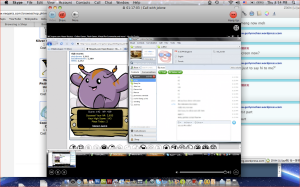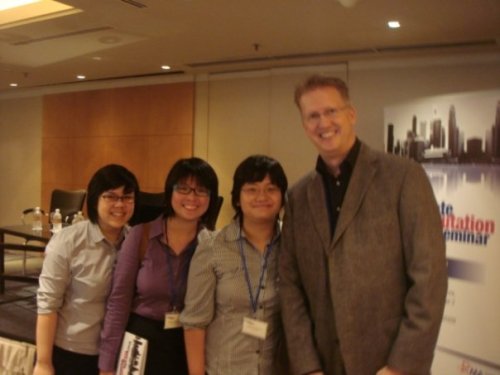We spent last Saturday afternoon at Barcamp. It was held at the IDA, Suntec City Tower 3.
It was my first time attending Barcamp, and it was a pretty interesting experience. It’s basically an event where people gather to talk about a variety of topics (Wikipedia called it “user-generated conferences”), and everyone’s encouraged to ask questions and share whatever they know about them. On Saturday, topics that people wanted to talk about were pasted on the walls, and we used tiny red stickers to vote for them. Get enough votes, the topic goes through, and you just pop into a room to listen to whatever the speaker has to say.
I attended 4 discussions.
1) “Learning How to Draw By Using Both Sides of the Brain” by JF Koh
The left brain is what makes you logical and analytical, while the right brain is what makes you creative and intuitive. Both sides are used in different aspects of our lives, but often one side becomes dominant. Koh explained that people in this day and age are conditioned to rely more on their left brains, rather than their right. I can fully understand that, and I think that it may be particularly evident in Singapore, where there seems to be a larger focus on Mathematics and Science.
He handed us pieces of paper and got us to draw a beach scene: the sun, the sea, a palm tree on an island with some birds flying around.
Um, naturally, my drawing barely looked like a drawing. To spare you the agony, I shall not reproduce it here.
The point Koh was trying to make in getting us to draw this was to teach us the theory of Association. Since young, we were taught to associate certain words with certain icons. Like a person with a stick figure, a sun with a yellow circle and lines pointing outwards etc. We grow so used to Association, thanks to our left brain, that we leave out the details and just draw the main, broadest details.
To combat this, he got us to to contour drawing. Place your hand on a piece of paper, and then try to draw its outline, taking note of various contours and spaces between your fingers. This helps you make better sense of shapes, sizes and minute details.
To find out if you’re a right or left-brained individual, here’re are some tests you can check out.
http://www.wherecreativitygoestoschool.com/vancouver/left_right/rb_test.htm
2. “Spiciest chilis in the world” by Nitin Pai
Food being so close to our hearts, this was one of my favourite discussions. I found out that the spiciness of chilis are measured by the Scoville scale, and that the two spiciest chilis in the world are Bhut jolokia, a thumb-sized chili pepper and the habanero chili. The speaker told us about some interesting recipes we could try out. One of them involves blending one of the 2 chilis I mentioned (I can’t remember which one) and then spreading it all over chicken wings. The other involves taking 5 or 6 chili padis, mixing it with some vodka and then allowing it to sit for awhile to get really spicy alcohol, I suppose.
No, I don’t have the guts to try it out, although the chicken wing recipe sounds really tasty. I’m hungry just blogging about it.
3. “For smart geeks: How to explain difficult concepts to lesser beings” by Coleman Yee
I was a bit worried about this presentation at first, because I thought it’ll be some boring, technical thing, but it definitely wasn’t. Coleman had an easy charm, and was rather charismatic, plus his explanations were really interesting and easy to understand. You can follow Coleman on Twitter @metacole.
While teaching people various concepts, we have to remember that we have “the curse of knowledge”. That while knowledge empowers us, it might also cripple us when we explain things to people, perhaps because we aren’t in their position and don’t understand why they aren’t getting it. In addition, we should always try to “oversimplify” things first before feeding bigger chunks of information to whoever you’re trying to teach. I think that this is an important lesson for us Communication students. All too often, people like to elevate themselves, throwing in big words during conversations cus they get a kick out of seeing the look of bafflement on others’ faces. We should remember that successful communication is defined by actually getting the message across. If people don’t get you, you have failed at being a good communicator. Check out his slides at www.metacole.com.
4. “(Tech) Tools to Personal Effectiveness” by James Norris
James Norris was affable, and a good speaker too. He comes from Texas and came to Singapore only 3 months ago. He showed us some tools on increasing personal effectiveness, like Excel sheets for you to fill in, ranging from those involving personal goals, your happiness levels and your fitness levels which can even generate charts and graphs to track your improvement. Organised, I’m not. So I better be getting me of those forms sometime soon. Check out his tools at www.jnorris.org
Till the next Barcamp. See you around!















